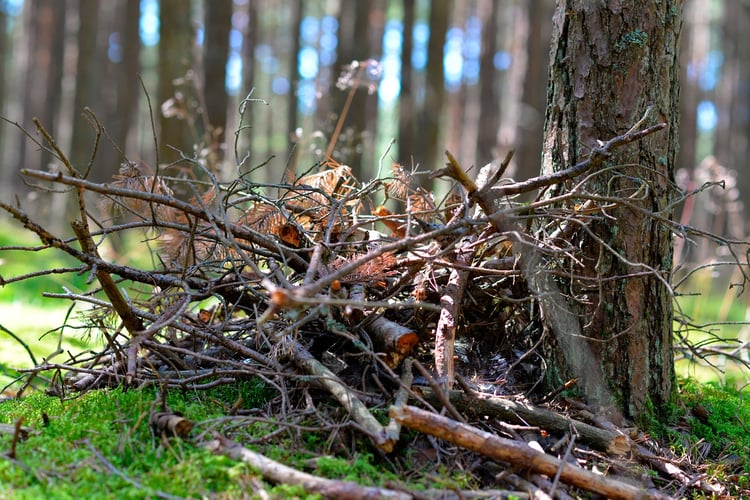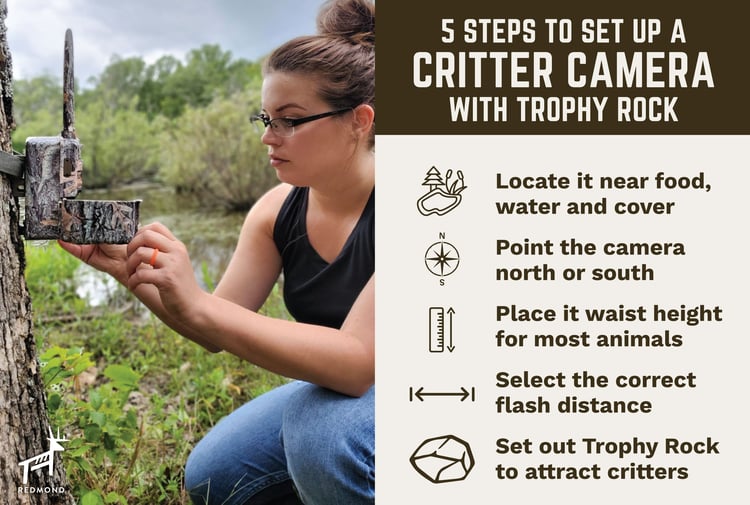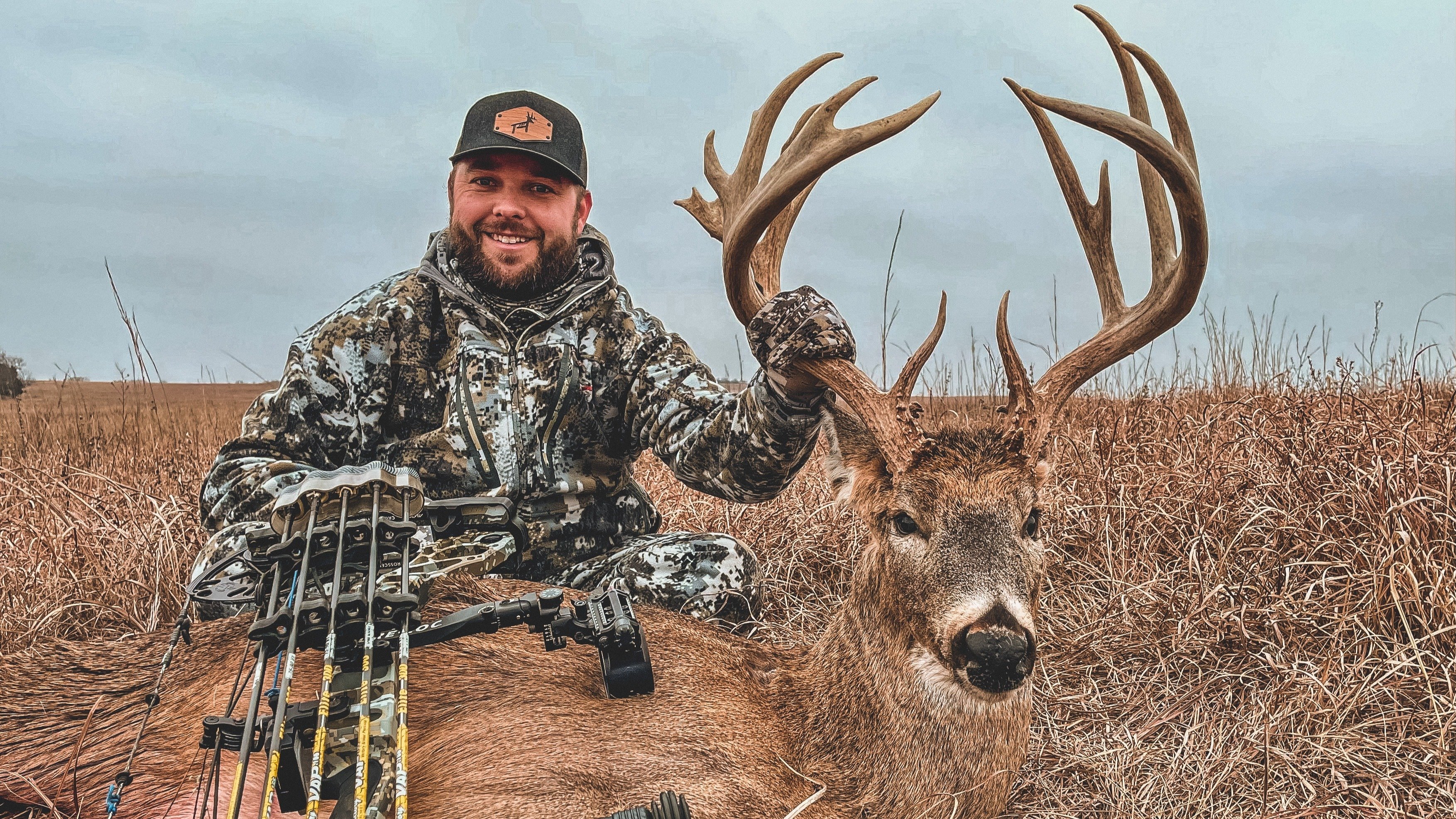Redmond Hunt Blog
How to Naturally Attract Deer & Wildlife to Your Backyard
Redmond Hunt March 13, 2024
Get tips on creating a backyard wildlife habitat, what to feed deer, and how to use Trophy Rock to attract animals to your yard or outdoor wildlife camera.
Attracting wildlife to your backyard is a great way to connect with nature right from home. An up-close view of local animals can be educational, fun, and relaxing. Especially when you’re enjoying the live entertainment from your own back porch, window, or camera! So how do you make it happen?
In this blog, we explore ideas on how to make your yard more inviting to animals—including creating a natural and nurturing habitat. We’ll also pass on tips about what to feed deer and other wildlife. Then finish up with expert advice on adding a critter camera to your property for fantastic viewing opportunities.
Create a Welcoming Backyard Wildlife Habitat
Making your backyard wildlife-friendly isn’t just rewarding—it’s also a meaningful way to support local ecosystems. With a few simple strategies, you can transform your yard or property into a haven for a variety of animals. Explore the ideas below to see which fit your goals and space.

1. Provide Watering Holes
No matter the time of year, wild animals need consistent access to clean water for survival. Adding a water feature to your property provides birds and other wildlife enjoyment and a reliable local watering spot—especially if you live in a dry area.
You can go all in and create a small wildlife pond if space permits. Or keep it simple with a store-bought or DIY birdbath. Whichever route you choose, a water feature is relatively easy to set up and serves multiple purposes for wildlife, from quenching thirst to splashing about for a cleanse.
Water features do require some attention to prevent bacteria, mud, and algae buildup, however. So, remember to drain and replace water often or install a filtration system to decrease the amount of maintenance.
2. Let Your Lawn Go Wild
Who doesn’t appreciate a swath of manicured grass that looks like a putting green? Besides flocks of Canadian Geese, not many other wildlife species!
If you have a large area of uninterrupted lawn, consider releasing a piece of it to the wild. Adding more untamed space to your property is a great way to make wildlife feel sheltered and at home. Below are a couple of ideas to get you started.
Create a Mini Meadow
Turn a portion of your lawn or property into a small meadow. The U.S. Fish & Wildlife Service notes meadows provide a welcoming habitat for deer, rabbits, foxes, frogs, butterflies, bees, birds, and more. Besides providing wildflowers, grasses, and an abundant food web, meadows furnish areas where animals can nest, feed, and hide.
This blog has helpful pointers on making a meadow from scratch or converting an existing patch of lawn by cutting back how often you mow and sewing native seed varieties or small plants into bare patches.
Build a Brush Pile
Limbs and brambles and leaves—oh my! Instead of burning that tangled pile of yard litter left over from cleanup, why not heap it up and leave it? It’s a quick way to turn a corner of your property into a wildlife haven.
You can build a brush pile (aka habitat pile) by stacking woody debris and loose leaves. It will make a snug retreat for chipmunks, squirrels, rabbits, raccoons, and birds. But be aware, weasels and foxes may also use it for shelter and hunting prey.
 The beginnings of a backyard brush pile where small animals can shelter from predators and weather.
The beginnings of a backyard brush pile where small animals can shelter from predators and weather.
The U.S. Fish & Wildlife Service recommends locating brush piles in areas that lack natural cover, such as:
- Clearings
- Fence rows
- Woodland edges
- Or near water and food sources
Over time, a brush pile will slowly settle and decay. Feel free to add to it as needed or start a new pile after a few years.
3. Provide Native Food Sources
You may feel tempted to feed deer and other wildlife to attract them to your backyard. However, unless it’s an emergency (and you’re using specially formulated feed) handing out meals for critters isn’t doing them any favors.
Animals have specialized diets, and introducing foods they aren't used to can be dangerous and even fatal. Feeding wildlife can also make them dependent on you, and they may lose their natural ability to forage.
All is not lost, though; you can still help nourish wildlife. Just create an environment where resources are naturally available so animals remain the champions of finding their own food. For example, plant food sources on your property that deer, squirrels, and other animals you’d like to attract favor. Think deer-approved woody shrubs, native flora, and oak, fruit, and nut trees that appeal to a variety of species.
Did You Know? There is one exception to the no-feeding rule, and that’s birds. Offering a snack to your feathered friends is A-OK. The U.S. Fish & Wildlife Service notes little to no indication that backyard bird feeding negatively impacts diet, behavior, or activities. So fill up the feeders! A diverse mix of seeds will attract an array of birds, with black oil sunflower seeds appealing to most.
4. Try Trophy Rock—Nature’s Original Wildlife Mineral & Attractant
There is another option for attracting deer and animals to your backyard that is a healthy and responsible alternative to feeding: set out an all-natural Trophy Rock salt lick! All animals require salt, but most don't receive enough from diet alone. That's why wild mammals and even birds often gather at natural salt deposits to consume the essential sodium and chloride they need to survive.
Trophy Rock is an organic mined salt rock that includes dozens of naturally occurring trace minerals essential to animal health. More than just an attractant, Trophy Rock is a natural salt lick that wildlife will instinctively seek out in their surroundings. It both attracts and nourishes without interfering with natural feeding habits.
- Natural and unrefined sea salt
- Balanced, full-spectrum trace minerals
- Mined in Utah, USA, from an ancient seabed
- Nutritious alternative to feeding wildlife
- Long-lasting wildlife attractant
- Perfect critter camera companion
Animals of all kinds love our natural wildlife mineral! Add it to your backyard or property to attract deer and a variety of interesting wildlife. Even certain bird species are drawn to salt, including purple finches, pine siskins, nuthatches, woodpeckers, blue jays, crows, and mourning doves.
 Animals and birds benefit from salt + minerals in Trophy Rock. Photo courtesy, Andrea Rothove.
Animals and birds benefit from salt + minerals in Trophy Rock. Photo courtesy, Andrea Rothove.
Elevate Wildlife Watching with Trophy Rock and a Critter Camera
Ready to take your backyard viewing up a notch? Try adding Trophy Rock and a game camera to your wildlife-watching supplies. Andrea Rothove from Browning Trail Cameras uses Trophy Rock to help attract and capture amazing photos of animals with her camera. Below you’ll find her picks for top wildlife cameras and pro tips to make your viewing experience come alive.
Best Wildlife Camera for Backyard Viewing
Andrea says finding the perfect game camera for your backyard or property really boils down to two objectives: “If you want mostly videos of wildlife, you’ll want a camera that captures high-quality videos. If your priority is crisp still images, you may prefer one with a higher image resolution.”
Another feature to consider is flash type, as certain animals may be wary of bright flashes.
“I’ve found most animals get used to a flash and it isn't much of an issue,” Andrea said. “But if you're unsure, I suggest going with a black flash camera. If you live in a populated area, a black flash also won’t draw attention to the camera at night.”
Top Critter Cam Picks
- Cameras that shoot high-quality HD videos with sound: Browning Recon Force Elite HP5 (visible, standard IR flash) or Spec Ops Elite HP5 (invisible black flash).
- Compact cameras that capture high-quality photos plus HD videos: Strike Force Pro DCL or Strike Force Pro X 1080.
How to Set Up a Backyard Wildlife Camera
Part of getting good images versus great ones is experimenting with the camera settings, height, and direction.
“See what works best for your location and the wildlife that shows up,” Andrea said. “I often move my trail cameras around a few times after checking the images until I am happy with the results.”
Here are a few pointers from Andrea when setting up a camera for wildlife viewing:
- Locate your camera near food, water and cover—three essentials for wildlife.
- Point the camera north or south to avoid sunrise/sunset light, which can affect image quality.
- Place the camera about waist height to capture larger animals like deer. Orient it lower if you want video or images of smaller animals.
- Select a farther flash distance if the area you’re watching is large and animals may not be close to the camera.
- Set out a Trophy Rock within your camera's vision to attract wildlife of all kinds.

“Most of all,” Andrea encouraged, “have fun, and don't be afraid to play around with angles and settings. You'll be surprised at how unique some of your images turn out, and the amount and variety of wildlife that show up right in your own backyard!”
Whether alone or paired with a camera, Trophy Rock will help you naturally attract wildlife to your yard or property. Click below to purchase now and begin enjoying the live entertainment from your window, deck, or game camera!
© Redmond Hunt 2024. All rights reserved.



.jpg)
